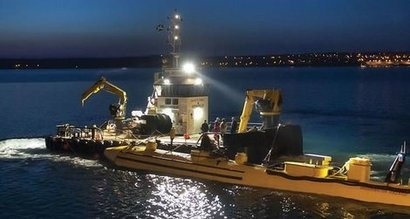
The deployment took place as part of preparations for the installation of the company’s SR2000 2 MW floating tidal turbine and is part of a novel tidal anchors project for floating technologies. The project was carried out in partnership with McLaughlin & Harvey, SeaRoc and Scotmarine, the aim being to develop an innovative low-cost anchoring system for floating tidal energy converters which could be readily installed and decommissioned, utilising low-cost vessels and demonstrating the anchors on the SR2000 turbine installation, the largest floating tidal turbine in the world.
The project was supported by the Scottish Government’s Marine Renewables Commercialisation Fund, which was established to support the development of enabling technology for marine energy arrays, and also by Invest NI. Scotrenewables has always chosen to engineer out lower cost workboat vessels over expensive, highly specialised vessels for all major aspects of installation, maintenance and decommissioning. This in turn enables cost reduction in the levelised cost of electricity (LCOE) from tidal energy generation. The engineering challenge has been to maintain this design approach as technology and anchoring requirements have increased in scale.
In order to achieve this, the partners have developed a novel installation methodology incorporating locally cast modular interlocking anchoring blocks that can be transported to the quayside and placed on the seabed. They can then be picked up for deployment on site using bespoke, specially designed, remotely operated lifting equipment mounted on readily available work boats.
The pre-cast fibre reinforced concrete anchor modules, each weighing in excess of 64 tonnes, were manufactured by McLaughlin & Harvey at a casting yard specifically set up within the harbour complex. They were then transported to the quayside at Hatston, Orkney, where they were placed on the seabed adjacent to the quayside by local heavy lifting engineers Heddle Construction. From there they were transported to the EMEC tidal test site by Scotmarine’s MV Orcadia II workboat with the help of the bespoke deployment frame. This process was refined so that multiples of modules could be safely deployed during a single working day.
These procedures have been developed from initial concept through to full-scale demonstration and deployment over the course of the two-year project, proving to be highly successful and with the last module installed just over a week ago. Final tests will be conducted shortly with the connection of the SR2000 expected in the coming months.
“The floating tidal anchors project has demonstrated how inexpensive gravity anchor materials can be utilised in conjunction with a highly innovative deployment approach towards a low cost anchoring solution for floating tidal installations” said Andrew Scott, Scotrenewables CEO. “The entire anchoring system was fabricated within Orkney and installed using a locally based workboat vessel, further illustrating how this approach can make full use of the local supply chain for tidal energy installations.”
Michael McSherry, McLaughlin & Harvey Marine Renewables Manager, added that the collaboration with Scotrenewables and Scotmarine drew on over 10 years of experience in the offshore renewables market resulting in the delivery of a cost-effective foundation for the SR2000 tidal turbine.
Scotrenewables Tidal Power Limited is an engineering company based on the Orkney Islands specialising in the development of a tidal energy turbine technology with the potential to produce a step-change reduction in the cost of energy from tidal stream flows. The company’s floating technology offers a low-cost solution for simplified and safe manufacture, installation, access and maintenance of units along with the ability to use low cost small workboats for all offshore operations.
McLaughlin & Harvey operate throughout the United Kingdom and Ireland, specialising on the delivery of quality building construction, fit-out, civil engineering, and facilities management projects. The company works in various sectors including health, education, industrial, retail, sporting venues, marine and rivers, transport infrastructure, offshore, energy, commercial, and leisure.
For additional information:

